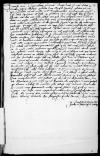Generoso domino ⌊Sigismundo de Herbstain⌋[1], consiliario et oratori ⌊caesareae maiestatis⌋, domino et amico observandissimo.
Generose Domine, commendationem plurimam.
Accepi ⌊⌋ Generositatis Vestrae, datas ex ⌊Reitten⌋ 1516-10-27⌊XXVII Octobris1516-10-27⌋, 1525-11-05⌊quinta huius mensis Novembris1525-11-05⌋ allatas ad me per quendam ad me missum a domino ⌊Vinsterwalter⌋, quibus mihi mentem ⌊caesareae maiestatis⌋ significat, utpote, quod quantocius irem ⌊Insprugk⌋. Hoc quam facerem libenter, nec dici nec scribi potest, cur autem fieri impraesentiarum adhuc non possit, intellexit ex litteris meis per ⌊Veit Hofer⌋ missis, in quibus omnes meas incommoditates et de famulo saucio etc. ac etiam de mea inopia perscripsi. Quaspropter Generositatem Vestram non rogo solum, verum confidenter obsecro, ut omnia ⌊caesareae maiestati⌋ exponat. Nihil renuo ⌊caesareae maiestati⌋, etiam si mox moriendum esset, dummodo clementius in me respiciat, ne videar omnibus hic mortalibus ludibrium. ⌊Ille⌋, qui famulum meum fraudulenter ac praeter causam sat dignam vulneravit, versatur cotidie in oculis meis et creditur omnia, quae perfide gessit, impune egisse, non sine mea magna ignominia. Misereatur quaeso mei Generositas Vestra, si forsan ⌊caesarea maiestas⌋ mei misereri gravabitur, propter quam tot nuper subivi pericula et omnes meas fortunas apud ⌊serenissimum dominum meum⌋, domum, ⌊parentes⌋, actiones, omnia denique mea reliqui, et consoletur me.
cf. Vulg. Est. 4:1 spargens cinerem capiti et in platea mediae civitatis voce magna clamabat ostendens amaritudinem animi sui ⌊Prae amaritudine animicf. Vulg. Est. 4:1 spargens cinerem capiti et in platea mediae civitatis voce magna clamabat ostendens amaritudinem animi sui ⌋ ac dolore summo plus de his scribere nequeo, videntur enim hae levitates mihi soli non illatae, sed domino etc. Praeterea quomodo mihi nunc est eundum? Viaticum non habeo. 1516-11-04⌊Heri1516-11-04⌋ accepi in mutuum non sine rubore a domino doctore ⌊Conrado Peutinger⌋ quindecim Renenses, cum quibus usque ad Generositatis Vestrae adventum vivere decrevi. Nihil recuso pro ⌊caesarea maiestate⌋, immo fideliter, ut consuevi, serviam, et serviam quam diu in vivis fuero. Consideret modo ⌊sua maiestas⌋, in quibus iactor procellis, potis est me facile eruere. Iturus sum quocumque ⌊maiestas sua⌋ mandaverit, nec patriae me desiderium detinebit. Non sum ut aspalacus, qui non nisi apud Boeotios, ubi nascitur, vivere potest[2]. Ego vivam undique et moriar, ubi ⌊maiestas caesarea⌋ voluerit. Proinde Generositatem Vestram rogo, procuret mihi apud ⌊maiestatem caesaream⌋, quae in rem meam ex litteris meis expedire videbuntur. Confidenter confido Generositatem Vestram pro amico obsequentissimo facturam. Cui me iterum iterumque commendo.
Ex ⌊Augusta⌋, quinta Novembris anno MDXVI.
⌊Ioannes Dantiscus⌋ eques Ierosolymitanus[3], doctor etc., serenissimi ⌊Poloniae regis⌋ secretarius.
[1 ] In the early days of his correspondence with Herberstein (CEID 2/1, letters No. 1, 2, 4-6) ⌊Dantiscus⌋ uses this syncopated form of his name. In ⌊Dantiscus’⌋ subsequent letters, the forms “Herberstain” and sometimes “Erberstain” appear. Herberstein himself usually signed his name as “Herberstain”
[2 ] Aspalax, Gr. – mole. Plin. Nat. 8, 226: item Boeotiae Lebadeae inlatae solum ipsum fugiunt, quae iuxta in Orchomeno tota arva subruunt, talpae. Plinius’ text, however, only speaks of the absence of moles around the Beotian town of Lebadea. Moreover, to denote a mole ⌊Dantiscus⌋ does not use the Latin word talpa (which Plinius uses), but the Greek aspalacus. This suggests that ⌊Dantiscus⌋ found the mention of Beotian moles not in Plinius’ work, but in a later text, e.g. a popular Physiologus. There are traces of how the quoted excerpt from Plinius functioned, though in slightly changed form, for instance in the works, popular at the time, of Jean Tixier de Ravisi (1480-1524) aka Ravisius: Aspalacus est animal, quod sola Boeotiorum terra fert. A qua translatum statim perire dicunt. Frequens est tamen apud Orchomenios (Cornucopie 1560, p. 15)
[3 ] ⌊Dantiscus⌋ traveled to the Holy Land in 1505-06. The title Eques Ierosolymitanus that he uses in signing some of the letters to ⌊Herberstein⌋, is meant to remind the addressee of this episode. To commemorate it, ⌊Dantiscus⌋ also ordered that a cross of the Order of the Hospital of St. John (the Baptist) of Jerusalem (the Jerusalem Cross) be placed on the heraldic right of his coat of arms on the reverse of the 1529 medal by Christopher Weiditz, and in the same position on his larger bookplate (probably wrongly dated to 1530-1532) and on binding stamp from 1539 (see
p. 160-161, cf. p. 5-6 and plate 2; Morka, p. 401, fig. 265;
IV, plate after p. 258; p. 24-25 and plate 7; p. 20-23 and plates 22-24: bookplates of ⌊Krzysztof Szydłowiecki⌋ ; p. 77, footnote 28; Skarby BN, p. 98-99;
p. 168, plate XIX 2

